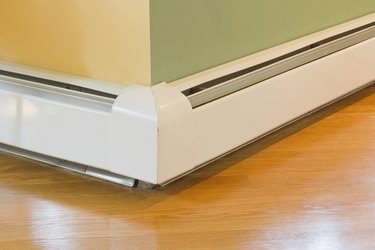
Baseboard water heaters offer an alternative to forced air systems for generating heat inside a home or building. The amount of heat generated depends on air flows within both the main heating unit and individual rooms. Damper mechanisms allow for heat regulation on a room-by-room basis, as well as within the system's main heating unit.
Baseboard Water Heaters
Video of the Day
A baseboard water heater system operates off a hot water boiler unit. Using circulator pumps, hot water moves through heating circuits contained inside baseboard units throughout a home. These systems generate convection heat that travels through the air and radiant heat that's absorbed by objects and surfaces within a room. The radiant heat feature resembles the type of heat generated by ultra-violet rays from sunlight. This type of heat has a lasting warming effect, compared to convection heat, which uses air molecules to circulate heat in a room.
Video of the Day
Heat Exchanges
A baseboard damper controls the level of heat in a room by affecting the heat exchanges that take place between the baseboard unit and a room's air environment. A baseboard unit consists of a casing or compartment that's usually situated below a window. The heating circuits contained inside the compartment have a fin-like surface, which increases the surface area distribution of heat into a room. Cold air enters the bottom part of the unit and is warmed by the heating circuit, then it is circulated into the room as warm air. The damper mechanism acts as a seal or partial seal to regulate the amount of heat that enters a room. And while a closed damper prevents heat from entering a room, the hot water system still circulates heat to a room's heating circuit when the boiler is on.
Temperature Gradients
Baseboard water heaters allow for a slow and even release of warm air into a room. Warm air enters the room at a low level, which works to convert temperature gradients from cool to warm in a ceiling-to-floor direction. As a result, this process pushes cold air down and into the baseboard register. In addition to the damper control mechanism, baseboard units may also include a thermostat dial that works along with the damper to control heat levels in the room. Baseboard units require open access to the entire room, so any type of barrier such as furniture or draperies can obstruct the flow of heat that circulates in the room.
System Dampers
System dampers function as a draft control component within the main heating unit of a baseboard water heating system. These dampers regulate how combustion gases move up and out of a system's chimney flue. Fan blower devices and air currents above the chimney generate drafts within the main unit's heat exchange compartment. The damper component works in conjunction with furnace sensors to regulate draft levels. Normal air flows send harmful combustion gases up through the chimney flue, while directing heated air to water heater units. In effect, a system damper allows the furnace to operate at optimal energy efficiency levels.